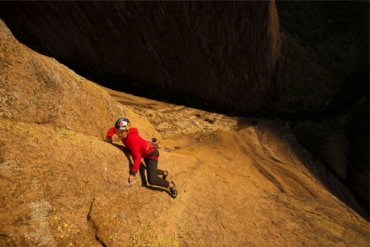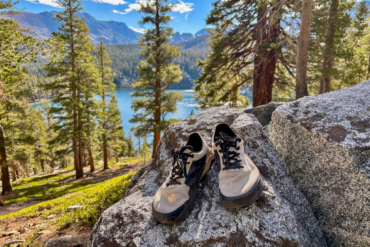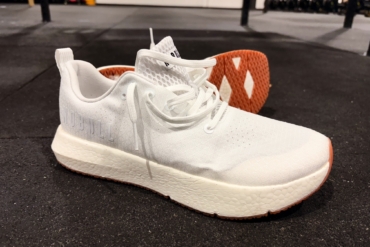A great fit and incredible heel round out a high-performance, all-around sport climbing shoe.
Spanish climbing brand Boreal first introduced sticky rubber to the climbing world in 1979 with the Firé rock shoe. That fueled Boreal to become one of the most recognized brands in climbing, especially in the ’80s and ’90s. Shoes like the Ace, Laser, and Ninja became weapons of choice for rock jocks.
And though the brand’s visibility shrank tremendously in the 2000s, Boreal is again attracting attention with a host of new shoes. That includes the sport climbing-specific Dharma. For this review, I spent 4 months testing the latest Dharma, released last year, on plastic, limestone, and granite.
Boreal Dharma Climbing Shoe Specs
- Microfiber upper with triple-strap closure and elastic tongue
- Boreal Zenith Pro outsole, 4-4.5 mm depending on size
- Slip-lasted with half-midsole
- Fully lined interior
- MSRP $160
- Verified weight: 1 pound 3.5 ounces per pair, men’s U.S. size 10
- For men and women
Boreal Dharma Climbing Shoe Review: Fit
Straight outta’ the box, the Dharma felt tight. But soon, it broke into one of the most well-fitting rock shoes for my classic “duck foot” — small heel and wide but vertically thin forefoot. It was a little difficult to get into the shoe because of elastic on the tongue and at the second hook-and-loop strap. But once on, the Dharma fit my foot with an almost custom-built feel.
The top strap of the Boreal’s three-strap closure became ornamental for me, as the shoe fit so well that additional security felt unnecessary. It’s one of the only shoes in recent testing that didn’t leave any bagginess in the upper on my low-volume foot.
The Dharma was aggressively downturned and asymmetric out of the box. Some downturn mellowed with use, but the downturn right at the toe and the concavity behind the toes formed by the midsole remained. The upper and toe box rand have a very pronounced bump-out for the knuckles of the big and second toe.
The arch felt moderately high, and a wide rand underneath supported my arch and maintained solid contact between my midfoot and the insole at all times.
The wide heel rand seems to run up high and be under high tension when the shoe is empty. But both the height and tension felt appropriate for aggressive climbing when the shoes were on my feet. The solid rubber heel cup feels more encompassing than other heel designs, and it gave the sensation that my entire heel was in contact with the rear of the shoe.
The Dharma’s terrycloth-like liner was comfortable, and the thick microfiber upper softened over time. The shoe didn’t change in length, but the upper did stretch out to provide more lateral and vertical room. I wear a size 10 running shoe, and the U.S. men’s size 10 Dharma felt true to size for a high-performance fit with the right amount of toe curl for steep climbing.
Boreal Dharma: 1st Impressions
The Dharma proved to be a medium-soft shoe. The midsole offered support for edging small holds on slightly overhanging routes and beyond, but going dead vertical on the same features begged for more stiffness.
 The sensitivity wasn’t on par with recently released super-soft shoes, but I found the compromise between stiffness and sensitivity well-suited for a wide array of intermediate-to-advanced sport climbing and bouldering.
The sensitivity wasn’t on par with recently released super-soft shoes, but I found the compromise between stiffness and sensitivity well-suited for a wide array of intermediate-to-advanced sport climbing and bouldering.
I only felt the need for softer shoes on the steepest limestone crags in my area. The Dharma fared well on all other high-angle terrain I encountered.
The downturn in the toe, concavity in the sole of the forefoot, and the bump in the upper for the toe knuckles all worked in concert to make pulling in with the toes on overhanging routes both powerful and comfortable. The rand tension never felt overwhelming, but it was enough to keep the toes tightly bunched in the front of the shoe for both sensitivity and power for pulling in and pressuring small features.
The bump-out for the toe knuckles was the most generous I have yet to encounter. It prevented the usual hot spot on that area when wearing high-performance shoes for a long duration.
Dharma Performance
The Dharma’s toe is moderately pointy, which made for effective pocket stabbing and pulling on pockets down to two-finger size. Smaller or shallower pockets required added effort, but the midsole concavity in the forefoot made pulling on the edge of larger pockets easier.
Toe-hooking in the Dharma proved effective; textured rubber covers most of the toe box upper. The Dharma was quite the heel-hooking machine; a textured rubber heel cup cradles the entirety of the heel and is quite stiff.
These attributes made high-force heel-hooking stable and comfortable. The heel never buckled, squirmed, or folded over. The downside was a lower level of sensitivity for heel-hooking tiny nubs on flat surfaces. My sensitive heels appreciated the heel cup, as it provided substantial cushioning.
The big downside of the Boreal Dharma to me was the Zenith Pro rubber compound. The grip was adequate when decent texture was present, and the shoe displayed good adhesion at my local granite area when smearing or edging on crystals. But on traffic-worn limestone, the Zenith Pro fell short compared to other compounds. These characteristics seemed more pronounced on plastic.
Boreal Dharma: Conclusions
The Boreal Dharma combines an excellent high-performance fit (for a low-volume foot or a small heel and wide forefoot), steep climbing prowess, and a superb heel design that presents a great all-around sport climbing and bouldering shoe for intermediate-to-advanced rock climbers. The material and construction quality seemed to match, promising great durability.
The only negative was the sub-par adhesion of the Zenith Pro outsole on smoother surfaces when compared to other compounds.










